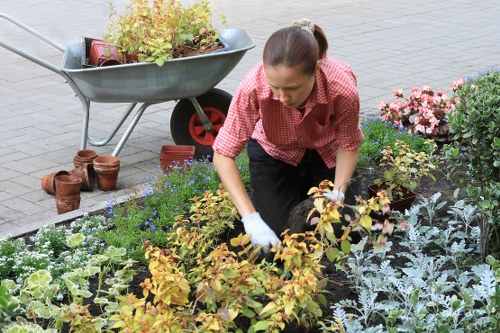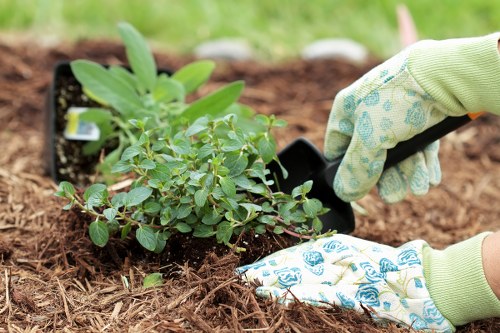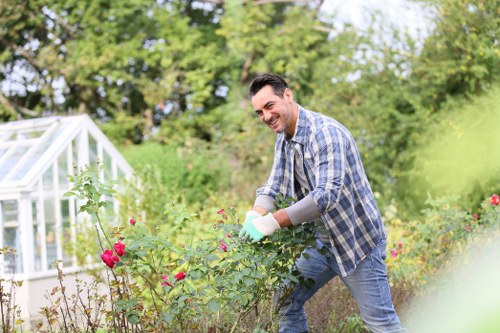Hedge Trimming in Stump Removal: Enhancing Your Landscape
Introduction to Hedge Trimming and Stump Removal

Maintaining a beautiful and healthy landscape involves various tasks, among which hedge trimming and stump removal are paramount. These activities not only enhance the aesthetic appeal of your property but also contribute to its structural integrity and safety. Proper hedge trimming ensures that your shrubs and bushes grow in a desired shape, while effective stump removal eliminates potential hazards and promotes a tidy environment.
Hedge trimming and stump removal require specialized tools and techniques to achieve the best results. Whether you’re a homeowner looking to improve your garden or a professional landscaper seeking to expand your services, understanding the intricacies of these tasks is essential.
This article delves into the best practices for hedge trimming in stump removal, providing you with comprehensive insights to maintain a pristine landscape.
The Importance of Hedge Trimming

Benefits of Regular Hedge Trimming
Regular hedge trimming offers numerous benefits that extend beyond mere appearance. It promotes healthy growth by removing dead or diseased branches, allowing sunlight and air to penetrate the foliage. This process helps prevent pest infestations and reduces the risk of fungal infections, ensuring that your hedges remain robust and vibrant.
Moreover, well-maintained hedges serve as effective barriers, providing privacy and defining property boundaries. They can also act as windbreaks, protecting other plants and structures from harsh weather conditions. A neatly trimmed hedge adds a touch of elegance and order to your landscape, making it more inviting and visually appealing.
In addition to these benefits, hedge trimming can enhance the overall value of your property. Potential buyers are often attracted to well-maintained gardens, and lush, trimmed hedges can be a significant selling point. Therefore, investing time and effort into regular hedge maintenance is a wise decision for both aesthetic and financial reasons.
Understanding Stump Removal

Why Remove Stumps?
Stump removal is a critical aspect of landscape maintenance that offers several advantages. Leaving a stump in your garden can lead to various problems, including the growth of unwanted sprouts, attraction of pests, and accumulation of debris. Moreover, stumps can be trip hazards, posing safety risks to both children and adults.
Removing stumps creates additional space in your garden, allowing for better placement of new plants and structures. It also eliminates the unsightly appearance of leftover tree remnants, contributing to a cleaner and more organized outdoor space. Furthermore, stump removal can prevent the spread of diseases and reduce the chances of termite infestations, protecting the overall health of your trees and plants.
Whether you choose to grind the stump or uproot it entirely, effective stump removal requires the right approach and tools. Understanding the various methods available can help you select the most suitable technique for your specific needs.
Techniques for Hedge Trimming in Stump Removal

Tools and Equipment
Having the appropriate tools is essential for efficient hedge trimming and stump removal. For hedge trimming, essential tools include pruning shears, hedge trimmers (manual or electric), and loppers. These tools allow you to achieve precise cuts, shaping your hedges according to your desired design.
For stump removal, you may require a stump grinder, which is a powerful machine designed to grind the stump below the ground level. Alternatively, manual methods such as digging and using an axe or a saw can be employed, although these are more labor-intensive. It’s crucial to select the right equipment based on the size and type of stump, as well as the surrounding environment.
Safety gear is also an important consideration. Wearing gloves, safety glasses, and protective clothing can prevent injuries during the trimming and removal processes. Ensuring that your tools are well-maintained and in good working condition is vital for achieving optimal results and minimizing the risk of accidents.
Best Practices for Hedge Trimming

Timing and Frequency
Choosing the right time for hedge trimming can significantly impact the health and appearance of your plants. Generally, the best time to trim hedges is during the late winter or early spring, before new growth begins. This timing allows the plants to recover quickly and encourages vigorous growth in the spring and summer months.
The frequency of trimming depends on the type of hedge and the desired shape. Fast-growing hedges may require trimming several times a year, while slower-growing varieties might only need annual maintenance. Regular trimming not only maintains the shape but also prevents the hedges from becoming overgrown and unmanageable.
It’s important to avoid trimming during extreme weather conditions, such as droughts or excessive rainfall, as this can stress the plants and hinder their growth. Monitoring the weather and planning your trimming schedule accordingly can help ensure the health and longevity of your hedges.
Effective Stump Removal Strategies
Grinding vs. Removal
When it comes to stump removal, there are primarily two methods to consider: grinding and complete removal. Grinding involves using a stump grinder to pulverize the remaining stump and roots, reducing them to small wood chips. This method is efficient and leaves the area clear for new planting or landscaping.
Complete removal, on the other hand, entails excavating the entire stump, including the roots, from the ground. This method is more labor-intensive and may require specialized equipment, but it provides a thorough solution, eliminating any chance of regrowth and fully clearing the area.
The choice between grinding and removal depends on factors such as the size of the stump, the extent of its root system, and your specific landscaping needs. Consulting with a professional can help you determine the most appropriate method for your situation.
Integrating Hedge Trimming with Stump Removal
Planning and Execution
Integrating hedge trimming with stump removal requires careful planning to ensure that both tasks complement each other and enhance the overall landscape design. Start by assessing the areas where hedges and stumps are located to determine the sequence of operations. It’s often advisable to begin with hedge trimming, as this can provide better access to the stumps, making the removal process more manageable.
When trimming, consider the placement of the hedges relative to the stumps. Properly trimmed hedges should guide the eye away from unsightly stumps and towards focal points in the garden, such as flower beds or seating areas. Additionally, maintaining a consistent height and shape for your hedges creates a harmonious look that ties the entire landscape together.
After trimming, proceed with stump removal, ensuring that the area is cleared of debris and any obstructions caused by the trimming process. This integrated approach not only maximizes efficiency but also results in a cohesive and aesthetically pleasing outdoor space.
Maintenance Tips for Long-Lasting Results
Regular Inspections and Care
To ensure that your landscape remains in top condition, regular inspections and maintenance are essential. Check your hedges periodically for signs of disease, pests, or damage, and address any issues promptly. Consistent trimming and pruning help maintain the desired shape and prevent overgrowth that can lead to difficulties in stump removal.
For stumps that have been removed, monitor the area for any unwanted sprouting or regrowth. Applying herbicides or other treatments can help prevent new shoots from emerging, maintaining a clean and clear landscape.
Additionally, caring for the soil around your hedges and removed stump areas can promote healthy plant growth and prevent erosion. Adding mulch or compost can improve soil fertility and retain moisture, benefiting both existing and newly planted vegetation.
Choosing Professional Services
Benefits of Hiring Experts
While some homeowners may opt to handle hedge trimming and stump removal themselves, hiring professional services offers numerous advantages. Professionals possess the expertise and experience to perform these tasks efficiently and safely, ensuring optimal results. They are equipped with the necessary tools and techniques to tackle complex jobs, such as removing large stumps or trimming intricate hedge designs.
Additionally, professionals can provide valuable advice on landscape design and maintenance, helping you make informed decisions to enhance your property’s appeal and functionality. By outsourcing these tasks, you save time and reduce the physical strain associated with manual trimming and removal efforts.
Furthermore, professional services often include guarantees and follow-up support, giving you peace of mind that the job will be done correctly and that any issues will be promptly addressed. Investing in expert help can lead to long-term benefits, ensuring that your landscape remains beautiful and well-maintained.
Environmental Considerations
Sustainable Practices in Hedge Trimming and Stump Removal
Sustainability is an important factor to consider when performing hedge trimming and stump removal. Opting for eco-friendly practices can reduce your environmental footprint and promote the health of your garden. For instance, using electric or battery-powered tools instead of gas-powered ones minimizes air pollution and noise levels.
When removing stumps, consider the disposal method of the wood chips and debris. Composting or mulching the material can enrich the soil and support new plant growth, turning what would be waste into a valuable resource. Additionally, recycling or repurposing wood from removed stumps can contribute to sustainable landscaping practices.
Choosing native plant species for your hedges not only supports local biodiversity but also requires less maintenance and water, making your landscape more resilient and environmentally friendly. Implementing these sustainable methods ensures that your hedge trimming and stump removal efforts contribute positively to the ecosystem.
Common Challenges and Solutions
Tackling Obstacles in Hedge Trimming and Stump Removal
Engaging in hedge trimming and stump removal can present several challenges, each requiring effective solutions. One common obstacle is dealing with thick or overgrown hedges that are difficult to trim. In such cases, using robust hedge trimmers with high-powered motors can make the task more manageable. For extremely dense growth, it may be necessary to trim in stages to avoid over-stressing the plants.
Another challenge is encountering large or deeply rooted stumps that are hard to eliminate. Utilizing a stump grinder can significantly ease this process, allowing for efficient removal without extensive manual labor. For particularly stubborn stumps, chemical treatments can be applied to accelerate decomposition, although this method requires careful handling to avoid environmental harm.
Safety is also a primary concern when performing these tasks. Accidental cuts or injuries can occur if proper precautions are not taken. Always wear appropriate safety gear, follow tool operation guidelines, and be mindful of your surroundings to minimize risks.
Enhancing Curb Appeal
Final Touches After Trimming and Removal
After completing hedge trimming and stump removal, adding final touches can significantly enhance your landscape’s curb appeal. Planting new shrubs or flowers in the cleared areas can breathe new life into your garden, providing vibrant colors and textures. Choosing plants that complement your existing hedges creates a harmonious and inviting environment.
Installing mulch or decorative stones around the base of your hedges helps retain soil moisture, suppress weeds, and provide a polished look. Additionally, incorporating garden lighting can highlight the beauty of your trimmed hedges and illuminate pathways, adding both functionality and aesthetic charm.
Maintaining cleanliness by removing any remaining debris and ensuring that all tools and equipment are stored properly also contributes to a well-kept appearance. These final steps ensure that your landscape remains attractive and welcoming, reflecting the care and effort invested in its maintenance.
Conclusion
Achieving a Beautiful and Functional Landscape
Hedge trimming and stump removal are integral components of landscape maintenance that significantly impact the beauty and functionality of your outdoor space. By understanding the best practices, utilizing the right tools, and considering environmental sustainability, you can achieve stunning results that enhance your property’s appeal and value.
Whether you choose to undertake these tasks yourself or enlist the help of professional services, prioritizing regular maintenance and thoughtful planning ensures that your landscape remains healthy, safe, and visually appealing throughout the year.
Embrace the art of hedge trimming and the effectiveness of stump removal to create a harmonious and inviting environment that you and your family can enjoy for years to come.
Contact us today to learn more about our professional hedge trimming and stump removal services, and book your service now to transform your landscape into a masterpiece.